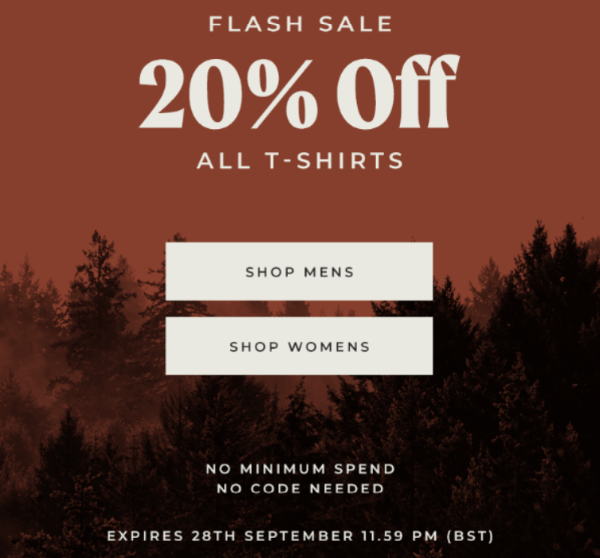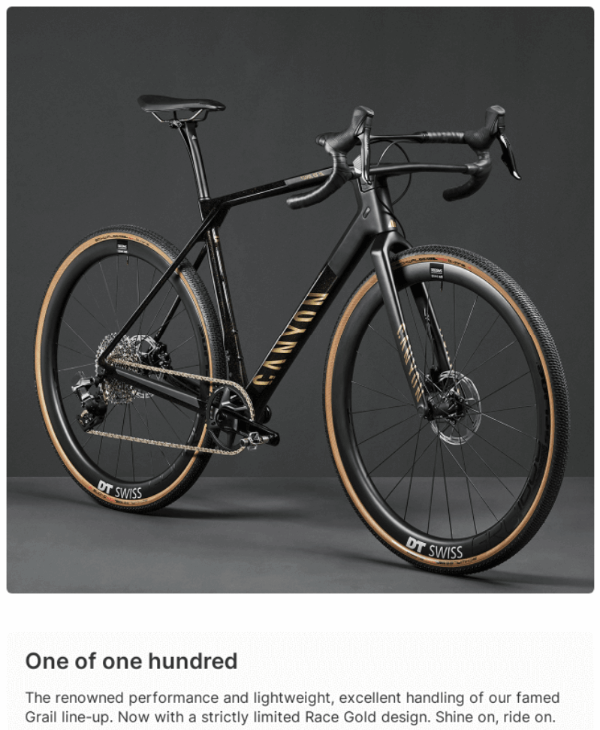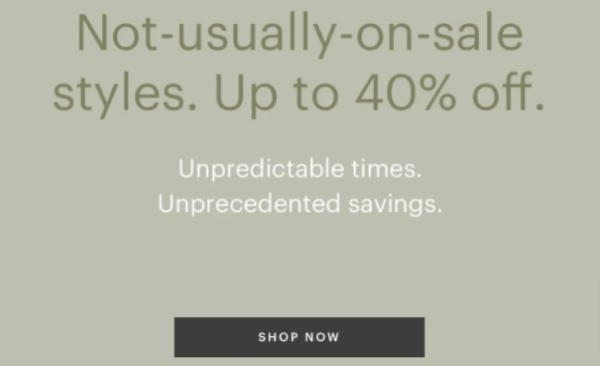While Supplies Last: 8 Scarcity & Urgency Tactics

Scarcity and urgency make us consumers do funny things.
Like loading up Ticketmaster on five separate devices as we try to score tickets for our favorite band.
Or sleeping outside an Apple store for a chance to buy the latest iPhone (do people still do that?).
Why do we act like this? Because we want something that’s in short supply.
You can leverage scarcity and urgency in e-commerce marketing to:
- Boost the perceived value of your products
- Foster a sense of exclusivity
- Compel customers to make faster buying decisions
All of which means higher conversion rates and more sales.
In this article, we’ll explain exactly how to use scarcity and urgency in your marketing — and provide plenty of real-world examples showing these tactics in action.
Why Use Urgency and Scarcity in Your Marketing?

The concept of using urgency and scarcity to bolster demand for products is nothing new.
When the seafaring Phoenicians became some of the ancient world’s wealthiest merchants through their control of the lucrative Tyrian purple dye market, we bet they used phrases like “while stocks last” and “limited-time offer” to make their product even more desirable.
But why has this sort of messaging enjoyed such popularity and longevity?
Because it works. And there’s plenty of evidence to prove it.
For instance, research published in the Journal of the Academy of Marketing Science examined limited-time products in the beer market to understand how scarcity and urgency impact consumer choice. Researchers found that the limited-time nature of a product leads to “a rapid jump in demand in the launching period”.
Meanwhile, a separate study published in the same journal concluded that:
“Product and resource scarcity both attract the consumer’s attention [and] increase the perceived value of the items being considered.”
In short, it seems that building an element of scarcity and urgency into your marketing can make your products more attractive, prompting customers to act fast to avoid missing out.
All of which is fantastic news for online retailers.
Now let’s consider some methods for baking urgency and scarcity into your own marketing…
How to Create The ‘While Supplies Last’ Effect
In this section, we’ll consider eight tried-and-trusted methods for leveraging scarcity and urgency to boost demand and drive sales, accompanied by examples from real brands.
Flash Sales
Three in four Americans say the majority of their purchases are spontaneous.
What better way to drive spur-of-the-moment spending than with a flash sale?
These promotions are unveiled at the last minute and are only available for a short period of time — typically from two to 36 hours. Some flash sales offer sitewide discounts; others only apply to a specific product category.
Flash sales can be promoted through various channels, from SMS and email marketing to organic and paid social media posts.
Here’s an email example from “purposeful living” brand P&CO, who used a flash sale to boost T-shirt sales:
Pro tip: As well as increasing conversion rates, you can leverage flash sales to bolster loyalty by offering early access to existing customers. That’s a big plus, with research from KPMG revealing that 86% of loyal customers will recommend a company to friends and family.
Countdown Timers
Even if you don’t spend as much time analyzing ecommerce stores as we do, you’re practically guaranteed to have encountered countdown timers in:
- Marketing emails
- Website banners
- Website popups
- Social media ads
- Product pages
These timers are essentially a visual representation of scarcity and urgency, showing customers that they’ve only got a short period in which to snap up a limited-edition product or take advantage of a juicy offer.
They might not be subtle, but they’re definitely effective. Indeed, research from Drip found that website popups convert an astonishing 113% better when they contain a countdown timer.

Give it a try yourself. Next time you run a sale, add a countdown timer to your homepage and product pages, rather than just referencing the end date.
Use countdown timers in your offsite campaigns too, like mattress brand Casper did in this Labor Day sale email:
Limited Stock
Flash sales and countdown timers are all about using urgency to drive sales: you’re providing a fantastic (time-limited) offer that customers don’t want to miss.
Of course, driving sales doesn’t have to involve discounting your products.
Another approach is to demonstrate the scarcity of your products by showing shoppers that you only have limited stock available.
The implication being: this product is in high demand, so you’d better act fast.
Verve Coffee Roasters illustrate product scarcity by adding a “low stock” badge to their collection pages:
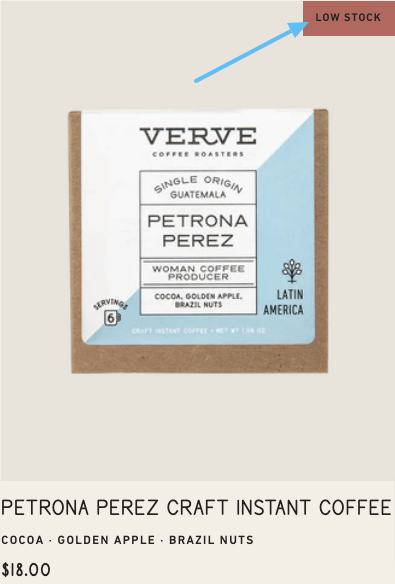
And they go a step further on the product page by revealing the quantity of products left in stock:
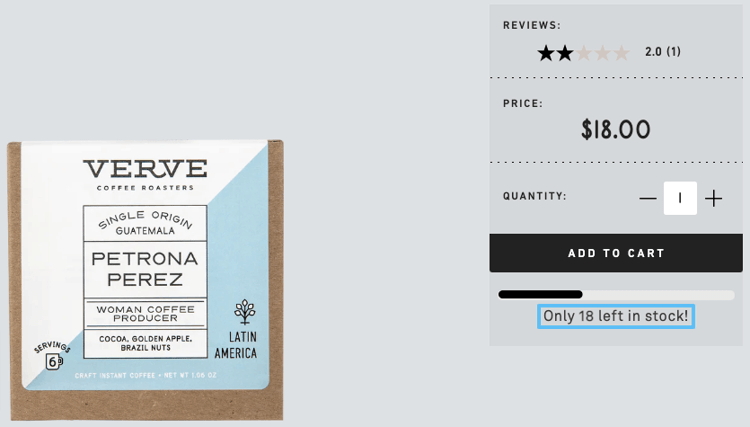
Of course, we have no context for whether 18 units is a high or low number. If Verve only sell one bag of Petrona Perez a month, that’s a ton of stock. But their use of the word “only” makes it seem like a low number, making the product feel more scarce.
Run a Shopify store? Find out how to do this yourself by reading our guide on how to add quantity on Shopify.
Limited Quantities and Product Drops
Sure, limited stock availability can happen due to supply chain issues or unexpectedly high demand.
But it can also be created artificially through limited-edition product drops.
This switches your messaging from “we currently have five in stock” to “we’ve only made five of these — and when they’re gone, they’re gone”.
You’ll likely recognize this tactic from the world of fashion, where brands like Kenzo and Supreme have used limited-edition launches to generate a ton of attention (and sales).
Often, these collections involve collaborations with high-profile designers and celebrities.
But it doesn’t have to be that complicated. In this example, bicycle brand Canyon promoted a limited-edition color of an existing product:
That way, Canyon leveraged the power of limited-quantity product drops without having to create a whole new product from scratch.
Show How Many People Are Viewing the Product
If you’re anything like us, whenever you walk by a packed-out restaurant, you instantly imagine how delicious the food must taste.
Again, it’s all about scarcity. The “thing” in question — like a table in our imaginary restaurant — is in short supply, so it seems more attractive to us.
And if a table opens up, we know we need to grab it fast.
That’s why highlighting other people’s interest in a product is such an effective way to boost sales.
There are various ways to leverage this strategy. For instance, you could tell customers that an item they’re viewing is currently in 10 other people’s shopping carts.
Or you could take a leaf from the book of Adored Vintage and demonstrate how many other shoppers are viewing the same product:
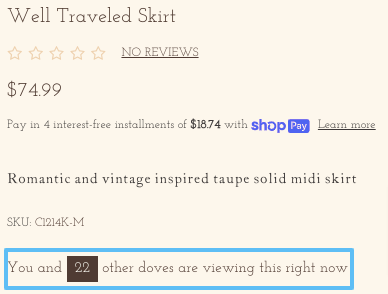
Pro tip: Try combining this approach with limited stock messaging. That way, you’re telling people that you have limited stock available and that lots of other people are interested in buying. That’s some persuasive marketing!
Load Urgency and Scarcity Into Your Copy
There are other ways to create scarcity and urgency beyond selling limited-edition products and demonstrating low stock levels.
Your copywriting plays a part, too.
From your website copy to your marketing emails and social posts, the words you use can go a long way to making your products and promotions seem more scarce. So whenever you’re writing marketing copy, compel shoppers to take action by using phrases like:
- Get yours while you can
- We hardly ever do this
- One day only
- Once in a lifetime
- Now or never
Fashion brand Everlane used this approach to increase interest in a flash sale:
Again, this example shows how you can use multiple scarcity and urgency-related tactics — in this case, combining a time-limited sale with scarcity-inducing copy — to craft even more compelling messaging.
Add Scarcity to Your Checkout Pages
Research from Gorgias found that repeat buyers account for 44% of the average ecommerce store’s revenue and 46% of orders — despite representing just 21% of customers.
This demonstrates the value of targeting existing customers with cross-sells and upsells.
And there’s no better time to do this than right after they’ve placed an order. After all, they’re clearly in the buying mood, so an attractive post-purchase upsell or cross-sell offer could persuade them to buy again.
For maximum effect, combine post-purchase offers with scarcity and urgency-related tactics.
Try cross-selling a low-stock product or offering a time-limited discount on your thank you page. Ideally, like Native Deodorant, you should make your offer more relevant by promoting a product that complements the customer’s original purchase:
Provide Limited-Time Free Shipping
It’s hard to overstate the impact of free shipping offers.
According to the Baymard Institute, high costs for “extras” like shipping and taxes are the #1 cause of shopping cart abandonments in the US.

Meanwhile, research from ReSci revealed that online shoppers are twice as likely to respond to free shipping offers than price discounts.
Okay, so we know that:
- Consumers love free shipping
- Scarcity and urgency-related messaging compels them to take action
So why not bring those two elements together by offering free shipping as a limited-time promotion?
That’s precisely what women’s fashion brand Cue did in this marketing email:
Don't Overdo Your "Whilst Supplies Last" Marketing
Just because urgency and scarcity are potent marketing tools, that doesn’t mean you should use them all the time. It shouldn’t be an always-on strategy or a crutch to prop up poor sales.
It’s kind of a boy who cried wolf situation: if you constantly tell customers that you’re low on stock or only selling a product for a limited period, the message loses all impact.
What’s more, research shows that stock shortages have a detrimental effect on ecommerce businesses, with 73% of shoppers saying they feel less loyal to brands after experiencing product unavailability. So if you keep warning shoppers that supplies are running low, you risk turning them off completely.
With that in mind, here are a couple of best practices to help you use scarcity and urgency intelligently without diluting your messaging:
- Explain why a product or offer is scarce. Is this a limited-edition product? Are you struggling to keep up with demand? Are you offering a promotion that’s so attractive you can only afford to run it for a short period? This sort of context brings real meaning to your messaging.
- Use scarcity and urgency to promote best-selling products. The tactics in this article will only work if there’s already some level of demand for your product. If no one wants to buy a specific item, that speaks to an underlying problem that won’t be resolved with a time-limited discount.
- Employ urgency and scarcity sparingly. In other words: don’t overdo it. Your goal here is to compel procrastinating shoppers to take action — not to pressure people to buy products they don’t actually want. Overdo it and you’ll end up with a bunch of returns on your hands.
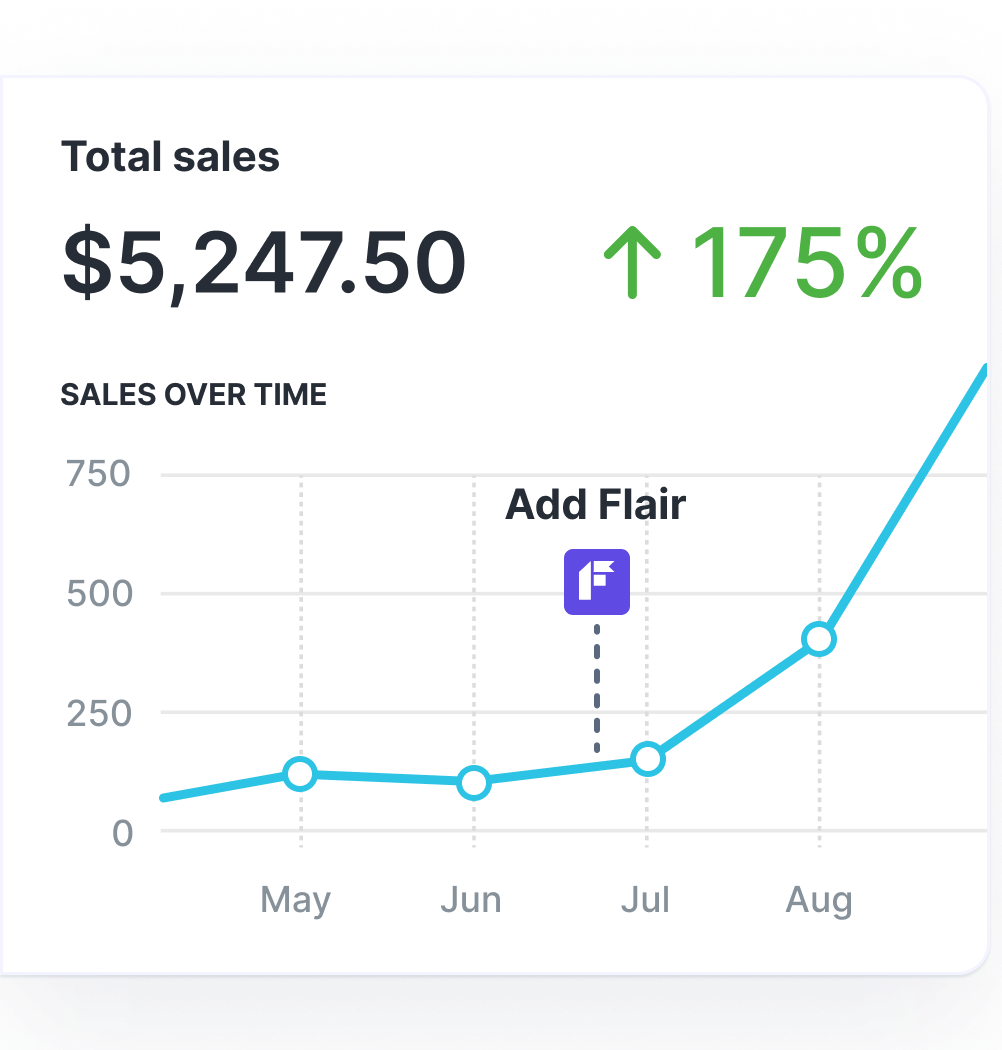
Grow Your Shopify Sales by over 175% with Flair
-
Increase sales using product badges and sales banners
-
Maximize conversions with scarcity, urgency and countdown timers
-
Automate promotions with targeted rules and scheduling
Conclusion
This article should leave you with two key takeaways:
- Urgency and scarcity can help you boost conversion rates, sales, and revenue.
- Overusing this type of messaging can annoy customers and damage your brand.
You should absolutely leverage scarcity and urgency in your campaigns; just don’t bombard customers with limited-edition product launches, flash sales, and limited-stock warnings.
Looking for some other ways to turn window shoppers into paying customers? Check out our 25 tips to increase Shopify conversion rates.
Other "While Supplies Last" FAQs
What Is an Example of Scarcity Marketing?
Supreme are one of the best examples of scarcity marketing, growing from a relative unknown into a brand generating $600 million revenues through their effective use of limited-quantity product drops.
Every week, they launch a limited run of new products that are practically guaranteed to sell out.
On “drop days”, traffic to Supreme’s site can increase by as much as 16,800%, while streetwear fans typically queue around the block at brick-and-mortar Supreme and Dover Street Market stores.
What Is Scarcity Strategy?
The scarcity strategy involves building demand for your brand, products, and promotions by limiting availability, with the ultimate goal of increasing conversion rates and sales.
There are lots of ways to leverage scarcity marketing, such as:
- Highlighting limited stock levels
- Releasing limited-edition products
- Demonstrating how many people are buying or browsing your products
Which is Correct: "While Supply Lasts" or "While Supplies Last"?
Both are totally valid.
However, the phrase “while supplies last” is far more common, generating over 20 times more monthly searches than “while supply lasts”, according to data from Ahrefs:


